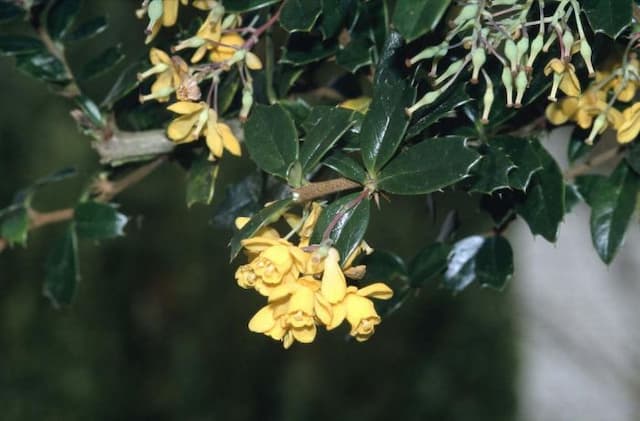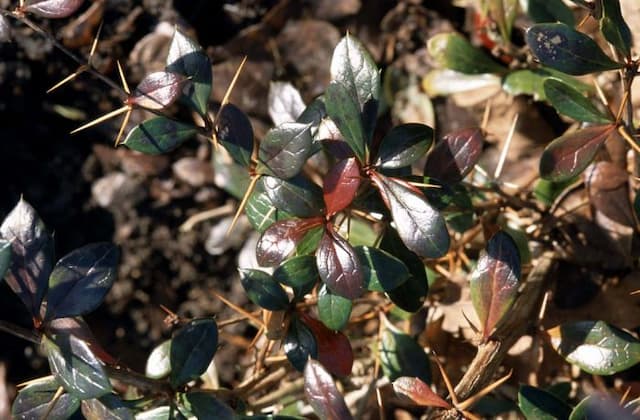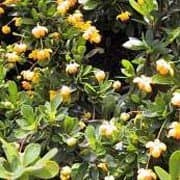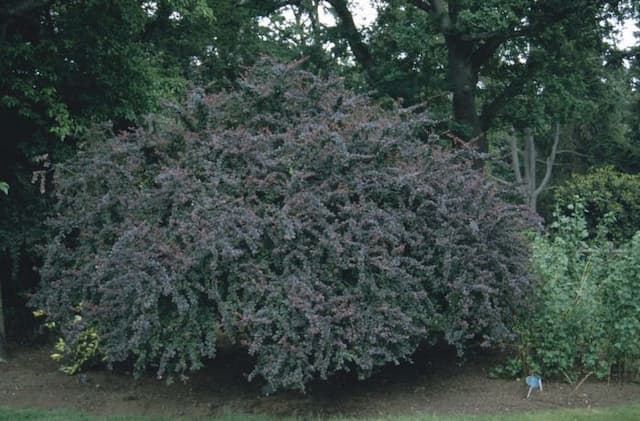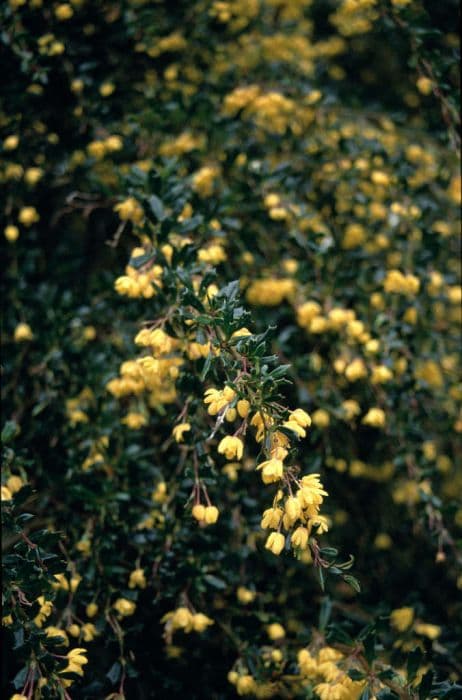Japanese barberry 'Boum' Berberis thunbergii 'Boum'

ABOUT
'Boum' is a compact, dwarf shrub with distinctive colouring. Flowers, as with most of the B. thunbergii cultivars, are pale yellow and relatively insignificant, but the leaves are variegated cream/green, contrasting with red stems. New shoots may be pink-flushed in all parts. Scarlet berries develop in autumn when theleaves also turn orange-red
About this plant
 Names
NamesFamily
Berberidaceae.
Synonyms
Japanese Barberry, Thunberg's Barberry, Red Barberry.
Common names
Berberis thunbergii 'Boum'.
 Characteristics
CharacteristicsLife cycle
Perennials
Foliage type
Deciduous
Color of leaves
Varies
Height
2 feet (0.61 meters)
Spread
2 feet (0.61 meters)
Plant type
Shrub
Hardiness zones
4
Native area
Japan
Benefits
 General Benefits
General Benefits- Drought tolerance: Berberis thunbergii 'Boum' can survive in dry conditions, making it suitable for xeriscaping.
- Low maintenance: It requires minimal care once established, making it ideal for gardeners seeking low-maintenance plants.
- Attractive foliage: The plant offers vibrant foliage that can add seasonal color to landscapes.
- Erosion control: Its root system can help stabilize soil on slopes, preventing erosion.
- Habitat for wildlife: It provides shelter and food for birds and other wildlife.
- Privacy and security: The thorny nature can deter intruders and is often used for hedges or security barriers.
- Tolerance to poor soils: It can thrive in less-than-ideal soil conditions, including urban settings with compacted soil.
 Medical Properties
Medical PropertiesThis plant is not used for medical purposes.
 Air-purifying Qualities
Air-purifying QualitiesThis plant is not specifically known for air purifying qualities.
 Other Uses
Other Uses- As a natural dye: The Berberis thunbergii 'Boum', commonly known as Japanese barberry, can be used to create natural dyes for textiles, yielding shades of yellow, green, and orange depending on the mordant used.
- In wildlife gardens: This plant can be incorporated into wildlife gardens to attract birds, which may feed on its berries throughout the winter months.
- Erosion control: With its dense root system, Japanese barberry can be effective in stabilizing soil and preventing erosion on slopes and banks.
- Privacy hedges: Its thorny branches and dense foliage make it a good choice for creating a living privacy screen in residential gardens.
- Topiary art: Japanese barberry is amenable to pruning and can be shaped into various forms for topiary art.
- Thematic gardens: It can be used in Asian-themed gardens to match its origin, thus contributing to the overall aesthetic and thematic consistency.
- Bonsai culture: The small leaves and natural habit of this plant suit it for training as a bonsai specimen for enthusiasts of the art.
- Culinary decoration: Though not a common use, the bright red berries can be used to add a splash of color to culinary presentations.
- Livestock fodder: In some cases, the leaves and shoots of Japanese barberry may serve as emergency fodder for livestock when other feed is scarce.
- Photographic subject: With its striking foliage and berries, this plant can serve as an interesting subject for nature photographers seeking to capture the beauty of different plant species.
Interesting Facts
 Feng Shui
Feng ShuiThe Japanese Barberry is not used in Feng Shui practice.
 Zodiac Sign Compitability
Zodiac Sign CompitabilityThe Japanese Barberry is not used in astrology practice.
 Plant Symbolism
Plant Symbolism- Resistance and Protection: Berberis thunbergii, commonly known as Japanese barberry, often symbolizes resistance and protection due to its thorny branches, which can create a formidable barrier against intruders or negative forces.
- Adaptability: Japanese barberry is known for its adaptability to different soil types and environmental conditions, making it a symbol of resilience and flexibility in various situations.
- Sharpness and Vigilance: The sharp thorns of Japanese barberry also represent sharpness in wit or intelligence, and the need for vigilance and caution in one's endeavors.
 Water
WaterJapanese Barberry requires regular watering, especially during its first growing season to establish a deep, extensive root system. Once established, water the plant deeply, rather than frequently, to encourage root growth. Watering should be done about once a week, depending on rainfall and soil conditions, supplying about 1 to 2 gallons per plant each time. During hot, dry periods, you may need to increase watering frequency, ensuring the soil does not dry out completely. In winter, reduce watering as the plant goes dormant and requires less moisture.
 Light
LightJapanese Barberry thrives in full sun to part shade. The ideal location is a spot that receives at least 4 to 6 hours of direct sunlight daily, which promotes the best foliage color and flowering. However, it can also tolerate light shade, especially in the hotter afternoons of summer to prevent leaf scorch.
 Temperature
TemperatureJapanese Barberry is a hardy plant that can withstand a wide range of temperatures, making it suitable for many climates. It can survive in temperatures as low as -30°F and as high as 100°F. The ideal temperature range for its growth is between 60°F and 70°F.
 Pruning
PruningJapanese Barberry benefits from pruning to maintain its shape, promote air circulation, and remove any dead or diseased branches. Pruning should be carried out in late winter or early spring before new growth starts. It’s generally sufficient to prune the plant once a year, but if shaping is desired or to control its size, additional pruning may be necessary during the growing season.
 Cleaning
CleaningAs needed
 Soil
SoilThe Japanese Barberry 'Boum' thrives best in a soil mix that is well-draining and rich in organic matter. A mixture of garden soil, peat moss, and perlite in equal parts can provide the ideal texture and nutrients. The soil pH should be slightly acidic to neutral, ranging from 5.5 to 7.5 to support healthy growth.
 Repotting
RepottingThe Japanese Barberry 'Boum' doesn't require frequent repotting; it is generally sufficient to repot the plant every two to three years. If the plant shows signs of being root-bound or the soil is exhausted, it may be necessary to repot more often.
 Humidity & Misting
Humidity & MistingThe Japanese Barberry 'Boum' tolerates a wide range of humidity levels and does well in the average outdoor humidity. There is no need for any specific humidity adjustments for this hardy shrub.
 Suitable locations
Suitable locationsIndoor
Ensure bright light and avoid overwatering.
Outdoor
Plant in sun or part-shade; water regularly.
Hardiness zone
4-8 USDA
 Life cycle
Life cycleThe Japanese barberry 'Boum' begins its life cycle as a seed, typically requiring stratification to break dormancy before germinating in the spring. Upon sprouting, it develops into a seedling, where it focuses on root establishment and foliage growth. As it matures, it enters the vegetative growth stage, forming a dense, compact shrub with green foliage that turns to reddish-purple in the fall. It reaches reproductive maturity within a few years, whereupon it produces small, yellow flowers in late spring, followed by bright red berries that persist into winter and serve as a food source for birds, facilitating seed dispersal. Throughout its life, which can span several decades, the plant undergoes seasonal changes, losing its leaves in the fall and becoming dormant in winter before re-emerging in the spring. The Japanese barberry 'Boum' is resilient and can spread both vegetatively, by rooting at the stems, and by seed, potentially becoming invasive in some regions.
 Propogation
PropogationPropogation time
Spring-Early Summer
The Japanese barberry 'Boum' is commonly propagated by softwood cuttings. This method is usually undertaken in late spring to early summer when the new growth is still flexible but mature enough to have a high chance of rooting. To propagate by cuttings, select a healthy, non-flowering stem and cut a piece approximately 4 to 6 inches (10 to 15 centimeters) in length, making the cut just below a leaf node. Remove the lower leaves to expose the nodes and dip the cut end into rooting hormone to enhance root development. The cutting should then be inserted into a moistened mix of peat and perlite, ensuring that at least one node is below the surface. The cutting needs to be placed in a warm and humid environment with indirect sunlight until roots establish, after which it can be potted up individually.
